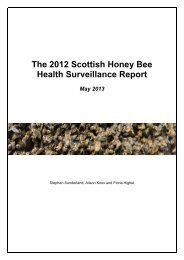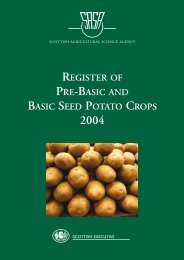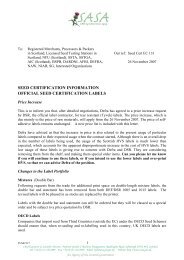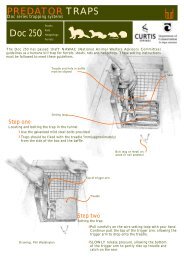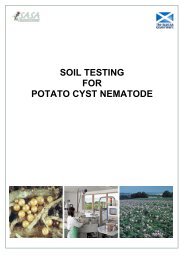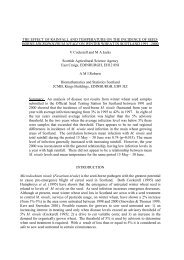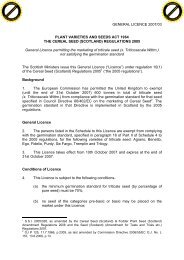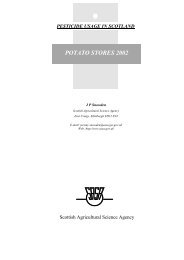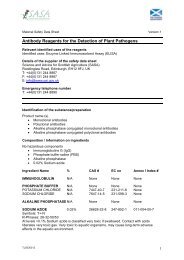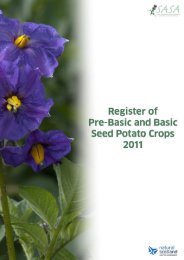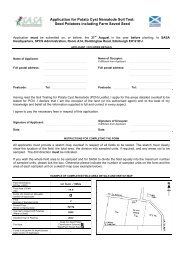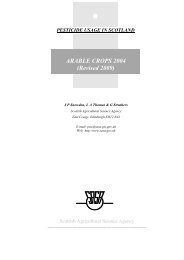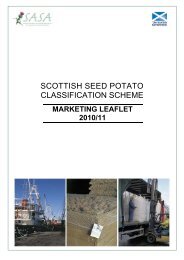You also want an ePaper? Increase the reach of your titles
YUMPU automatically turns print PDFs into web optimized ePapers that Google loves.
<strong>Crop</strong> <strong>Production</strong> <strong>in</strong> <strong>the</strong> <strong>East</strong> <strong>of</strong> <strong>Scotland</strong>Figure 2.2 Mean August and September ra<strong>in</strong>fall at three meteorological stations <strong>in</strong><strong>the</strong> <strong>East</strong> <strong>of</strong> <strong>Scotland</strong>, 1961 – 1999. The curve is fitted to five-year runn<strong>in</strong>gmeans.although <strong>the</strong>re is considerable variabilityfrom year to year (Table 2.1). There is atendency towards drier wea<strong>the</strong>r <strong>in</strong> Februaryto April, and <strong>the</strong> harvest months <strong>of</strong> Augustand September can be very wet (Figure2.2). The driest areas are those on <strong>the</strong>South-<strong>East</strong> and Moray Firth coasts where<strong>the</strong> average annual ra<strong>in</strong>fall is less than600 mm. Annual precipitation <strong>in</strong>creases to<strong>the</strong> west because <strong>of</strong> an <strong>in</strong>crease <strong>in</strong> altitudeand proximity to <strong>the</strong> wetter west coast. As arule <strong>of</strong> thumb, arable agriculture is notviable when annual ra<strong>in</strong>fall exceeds1000 mm.In <strong>Scotland</strong>, ra<strong>in</strong>fall per se is not usually <strong>the</strong>limitation to agriculture but ra<strong>the</strong>r soilwater status, which depends on <strong>the</strong> balancebetween precipitation on <strong>the</strong> one hand andlosses from evapotranspiration anddra<strong>in</strong>age on <strong>the</strong> o<strong>the</strong>r. Temperature sets <strong>the</strong>potential length <strong>of</strong> <strong>the</strong> grow<strong>in</strong>g season forall crops, as outl<strong>in</strong>ed above; however, withmechanised agriculture, <strong>the</strong> actual grow<strong>in</strong>gseason is effectively restricted to <strong>the</strong> periodwhen <strong>the</strong>re is a soil water deficit (Table 2.1),so that <strong>the</strong> soil is sufficiently strong tosupport <strong>the</strong> weight <strong>of</strong> cultivat<strong>in</strong>g, plant<strong>in</strong>gand harvest<strong>in</strong>g mach<strong>in</strong>ery without suffer<strong>in</strong>gdamage. There is very considerable <strong>in</strong>terannualvariation <strong>in</strong> soil water content,superimposed on <strong>the</strong> annual cycle. Forexample, Francis (1981) estimated that, over<strong>the</strong> years 1957-75, <strong>the</strong> first soil moisturedeficit <strong>in</strong> spr<strong>in</strong>g occurred outside <strong>the</strong> period21 February to 20 March <strong>in</strong> half <strong>of</strong> <strong>the</strong>grow<strong>in</strong>g seasons; <strong>the</strong> correspond<strong>in</strong>g rangefor autumn return to field capacity was 20October to 30 November (Hay, 1993). Thedifference between <strong>the</strong> actual and potentialgrow<strong>in</strong>g season can, <strong>of</strong> course, be reducedby <strong>the</strong> use <strong>of</strong> w<strong>in</strong>ter-sown or perennialcrops, thus reduc<strong>in</strong>g <strong>the</strong> need for traffic <strong>in</strong>spr<strong>in</strong>g.Over <strong>the</strong> twenty year period up to 1999, <strong>the</strong>cumulative ra<strong>in</strong>fall from April to July (<strong>the</strong>ma<strong>in</strong> period <strong>of</strong> crop growth) ranged from50 to 150% <strong>of</strong> <strong>the</strong> mean, such that cropestablishment could be h<strong>in</strong>dered as muchby too little as by too much soil water.August and September ra<strong>in</strong>fall (Figure 2.2),which is important for <strong>the</strong> harvest <strong>of</strong>cereals, bulk<strong>in</strong>g <strong>of</strong> ma<strong>in</strong> crop potatoes and(October) drill<strong>in</strong>g <strong>of</strong> w<strong>in</strong>ter cereals, is alsora<strong>the</strong>r variable. W<strong>in</strong>ter ra<strong>in</strong>, which<strong>in</strong>fluences <strong>the</strong> leach<strong>in</strong>g <strong>of</strong> nutrients over<strong>the</strong> w<strong>in</strong>ter period and <strong>the</strong> degree <strong>of</strong>20



